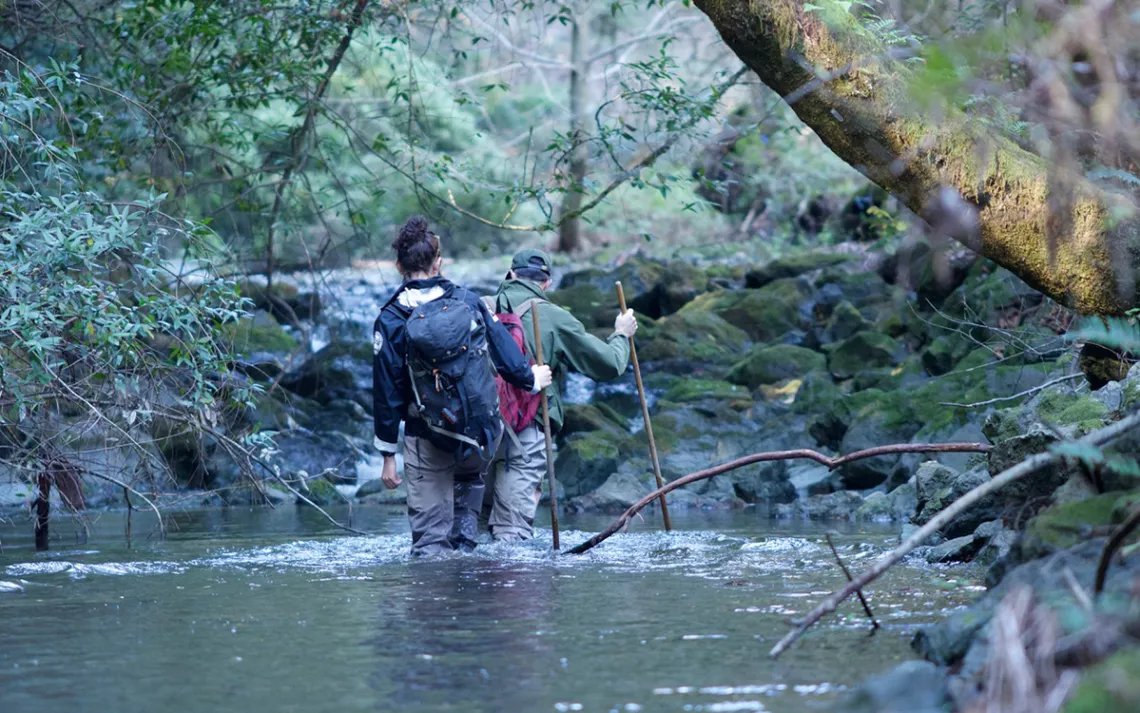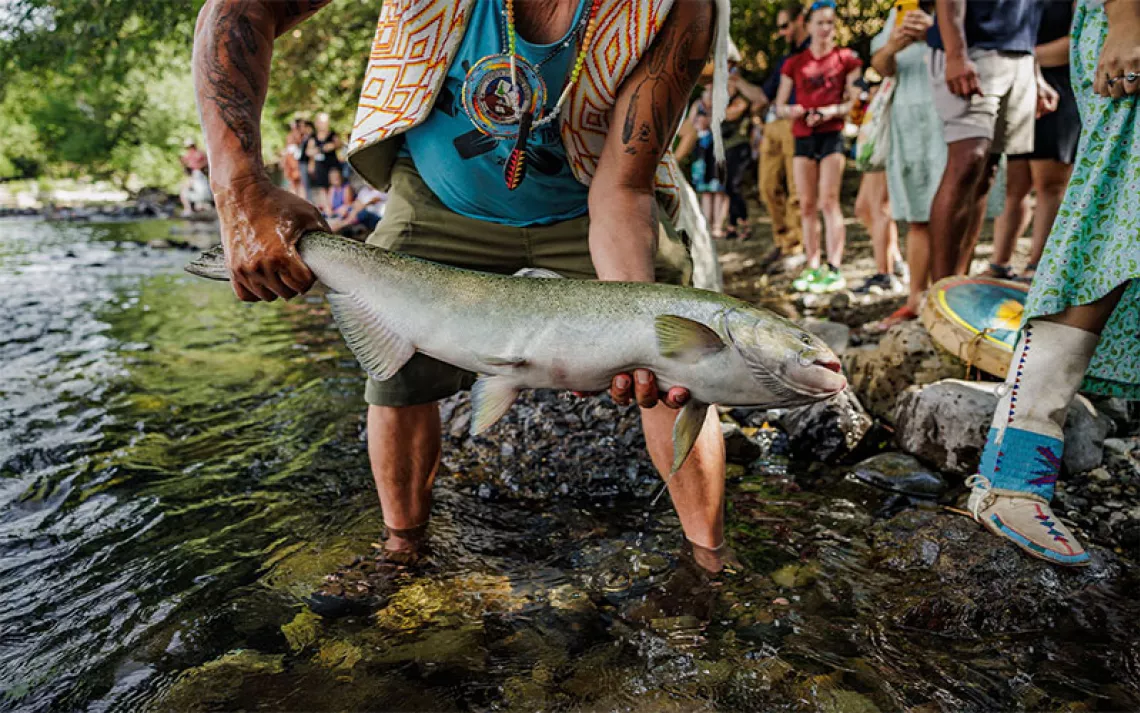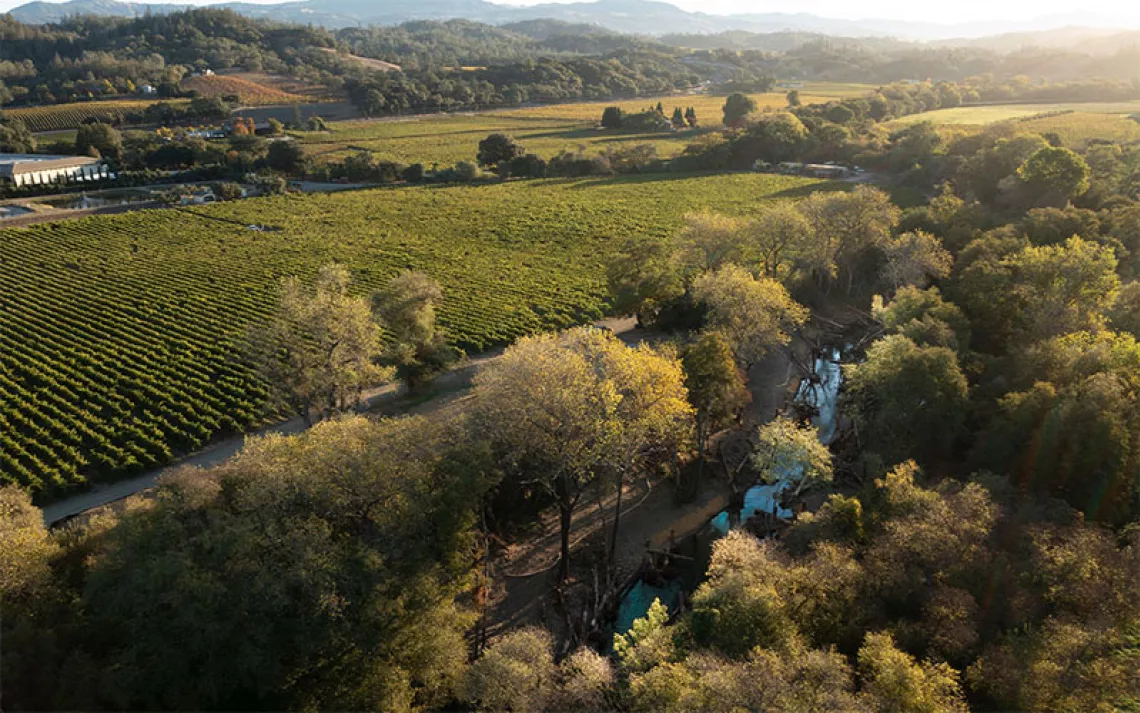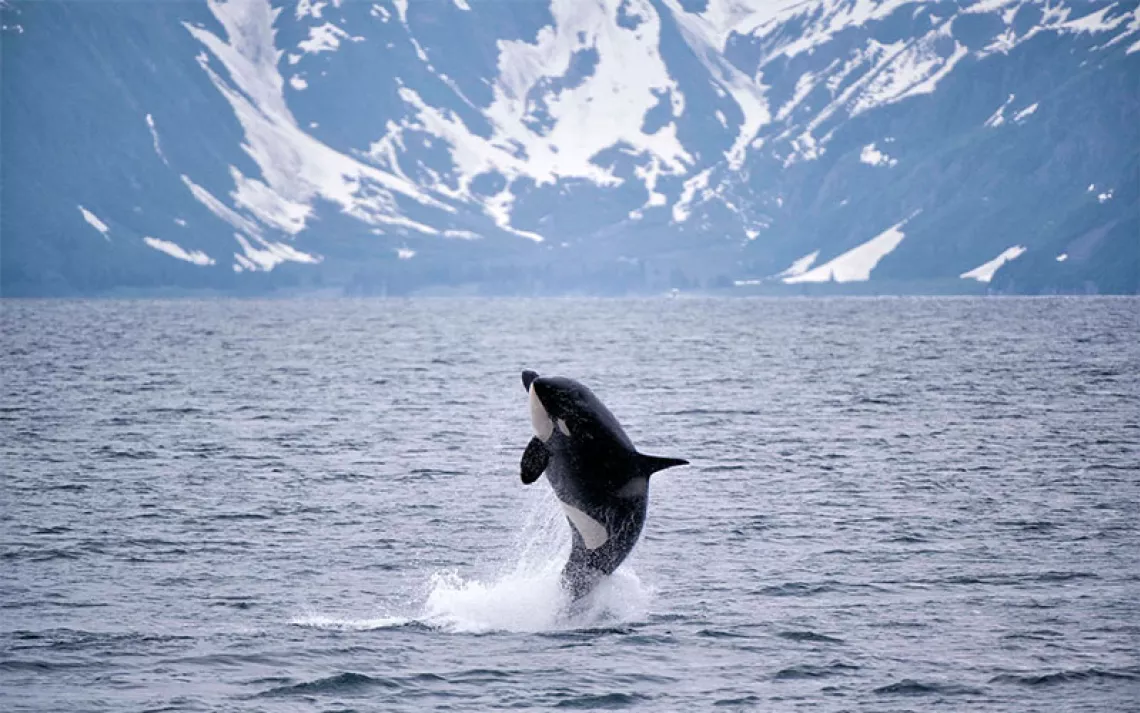Salmon Returned to California Creeks. Now Drought Has Too.
After a wet fall, the recent lack of rain leaves fish eggs high and dry

Michael Reidchmuth and Natale Urquhart search for redds in Redwood Creek, which runs through Muir Woods National Monument. | Photos by Jeremy Miller
A few weekends ago, crowds flocked to San Francisco Bay Area creeks to get a rare look at native salmon. Record storms in October and December had swelled local waterways, and large numbers of the anadromous fish had swum up from the ocean to their spawning grounds. Endangered Coho salmon were showing up in dozens of places, including Montezuma and Larsen Creeks, small tributaries of San Geronimo Creek, where they hadn’t been seen in nearly 20 years. Several stray Chinooks even made an appearance in Oakland’s urban lagoon, Lake Merritt. The proliferation of salmon was hailed as a hopeful sign of recovery for the long-embattled species and an encouraging signal that the decades-long drought might be loosening.
But those hopes were quickly dashed in January. Along much of the central and northern California coast, it didn’t rain or snow the entire month, marking one of the region’s driest Januarys on record. Snowpack in the Sierra went from 168 percent of average in December to just 93 percent in February. A mid-January wildfire along the Big Sur coast hammered home the sudden severity of the dryness. Most long-term forecasts call for more of the same through the end of February.
The lack of rain has brutally cut short what started out to be a historic salmon run. The region’s waterways—which just weeks ago were overflowing—have since been reduced to below-average flows. Hoping to better understand the consequences of the resurgent drought on the region’s salmon, I joined a team of researchers on an unseasonably warm Sunday at the end of January, along a nearly two-mile stretch of Redwood Creek, which flows through Muir Woods National Monument. The crew of four was headed by Michael Reichmuth, a fisheries biologist for the National Park Service who heads up the Coho and steelhead monitoring program. For close to 20 years, Reichmuth has evaluated the health of salmon runs in Golden Gate National Recreation Area, an assemblage of public lands that in addition to Muir Woods includes Marin Headlands and Point Reyes National Seashore. I ventured upstream with him and Natale Urquhart, a recent graduate of Humboldt State University and member of the California Conservation Corps Watershed Stewards Program (in partnership with Americorps).
We stepped gingerly through the creek as it meandered between towering redwoods. On a trail beside the stream, throngs of visitors trained their eyes upward on the ethereal canopy of the forest, but Reichmuth's and Urquhart’s gazes were firmly fixed on the water. Weeks earlier, the creek had been teeming with adult salmon.
An adult Coho salmon in Lagunitas Creek in early January.
The probability of seeing an adult fish on our outing was slim. “The water is just getting too low,” Reichmuth said. The ones that were here weeks ago had disappeared—after laying their eggs they died and their bodies, some well over two feet long, were quickly devoured by animals. Instead, Reichmuth and Urquhart devoted their attention to the creek bottom, searching for shallow depressions and mounds in the gray-green river cobble. These structures, known as redds, had been excavated by spawning salmon and another species native to the creek, steelhead trout. Pieces of colored flagging tied to tree branches marked the location of many of the redds. Reichmuth and his team had tied them there when they passed through in January. Hundreds of salmon eggs—and the future of the species that spawn in these small streams hemmed in by the Bay Area’s urban sprawl—lay inside each mound.
Reichmuth and Urquhart deftly maneuvered over fallen logs and along crumbling banks. As we pressed on, we could see that the water had dropped markedly. Side channels that a few weeks ago carried a robust flow of water were now completely dry. We came upon a heap of small stones and gravel poking up in the middle of the stream—the mound of a redd. A week earlier, it had been fully submerged. Now the top was above water, and the eggs inside were at risk of drying out.
In short-run coastal streams like Redwood Creek—which spans a mere five miles from source to sea—there is little margin for error. The incubation period for salmon eggs is around two months. Eggs laid in early January won’t hatch until early March. Without significant storms to replenish the flow, Reichmuth said, the water level will continue to drop, threatening the survival of this nest and dozens of others in the creek.
As the climate dries and rains shift to later in the winter, the Coho, which have evolved to time their runs to early winter rains, have suffered immensely. In fact, the population on Redwood Creek declined so precipitously that, between 2014 and 2019, the NPS and the California Department of Fish and Wildlife implemented a rescue and captive rearing program. Juvenile salmon were captured at the creek and then raised at the nearby Warm Springs Hatchery, at Lake Sonoma. (The program was halted, Reichmuth added, because the hatchery ran out of room.) Once the fish reached sexual maturity, they were released back into the creek. “You know you’re going to have a high mortality in the creek, so the best bang for your buck is to rear them in the hatchery,” Reichmuth said. “You may not get 100 percent survival in the hatchery, but you are going to get better than 2 percent.”
Drought and climate change are hardly the only threats to the Bay Area’s salmon populations. Though this stretch of Redwood Creek flows through a protected reserve, the impacts of hundreds of thousands of visitors each year walking the trails and, in some places, tramping through the creek itself, are significant. Outside the monument, water diversions and urbanization have altered, degraded, and destroyed huge swaths of habitat. Roads tend to follow the course of waterways—and this has proven disastrous to anadromous fish. One recent study found that toxins shed from tires have led to mass die-offs of salmon along the US West Coast.
We continued upstream, ducking under footbridges. Soon we entered the famed Cathedral Grove, where 300-foot-tall trees towered overhead. Sunlight diffused through the dense canopy as if passed through heavy fabric. The forest evoked a time before human contact, but the section of creek through which we walked, Reichmuth noted, was a manmade contrivance.
In the early 1900s, the channel was modified to prevent flooding of the trails as well as the visitor center and parking lot below. “Notice how in this reach we can see up and down the creek,” Reichmuth said. He pointed to large boulders along the bank. Covered in moss and vegetation, the rocks, so-called riprap, looked natural. But they had been placed to keep the stream within its banks and force the water to flow more quickly down its bed. As a consequence, the creek lost its meanders and deep pools, which provide a haven for spawning salmon and rearing area for juveniles. The reconfiguring of the creek to make it flow faster also exacerbates the impacts of drought, since the water has no time to seep in and recharge surrounding groundwater. “None of this is good for salmon,” Reichmuth said.
In a few minutes, we arrived at a section where the riprap had been removed. The banks sloped gently to the edge of the creek and the ground was covered in a burlap-like fabric dotted with seedlings. Here and there, large stumps and logs had been strategically placed in the creek bed. This, explained Reichmuth, was the first phase of a restoration project begun in 2019 that, when completed, will re-create some of the natural contours of the creek.
We kept going, and the creek constricted, running through a series of small cascades. Ahead of us, a massive redwood that had toppled in a recent wind storm spanned the stream. “Some might think it’s sad when one of these old, giant trees falls down,” said Reichmuth. “But to a fisheries person like me, it’s wonderful. It creates beautiful habitat for salmon.”
Suddenly, in slow-moving water along the bank, Reichmuth saw a flash. It was a baby salmon that had just emerged from a redd. The tiny fish, he said, was likely not a Coho but the offspring of another, unexpected visitor that arrived at the creek in large numbers late last year. In November, around 100 Chinook, which are much larger than Coho, were counted in the stream. Reichmuth said there is no record of Chinook in Redwood Creek and speculated that they may have come from releases of juvenile salmon at Fort Baker, at the foot of Golden Gate Bridge, which took place a few years earlier.
Our final stop was a beautiful pool fed by a cascade pouring over a fallen log. Urquhart pulled her phone from the front pocket of her waders and cued up a video that she’d taken a few weeks earlier. It was the same pool, but it was filled with several inches more water. Below the pour-off, a school of large Chinook salmon swirled and darted from the depths. “It was an amazing sight, a dozen huge fish crammed into that small pool,” Reichmuth said.
The three of us climbed out of the gorge and returned to the trail. As we walked back beneath the towering trees, Reichmuth mused on the creek and its beleaguered salmon. “Some people are ready to simply write off these runs,” he said. “I’m not. They can bounce back if we allow them the space and provide them with the right kind of habitat. If there’s one thing I’ve learned, it’s that nature will always surprise you.”
 The Magazine of The Sierra Club
The Magazine of The Sierra Club



